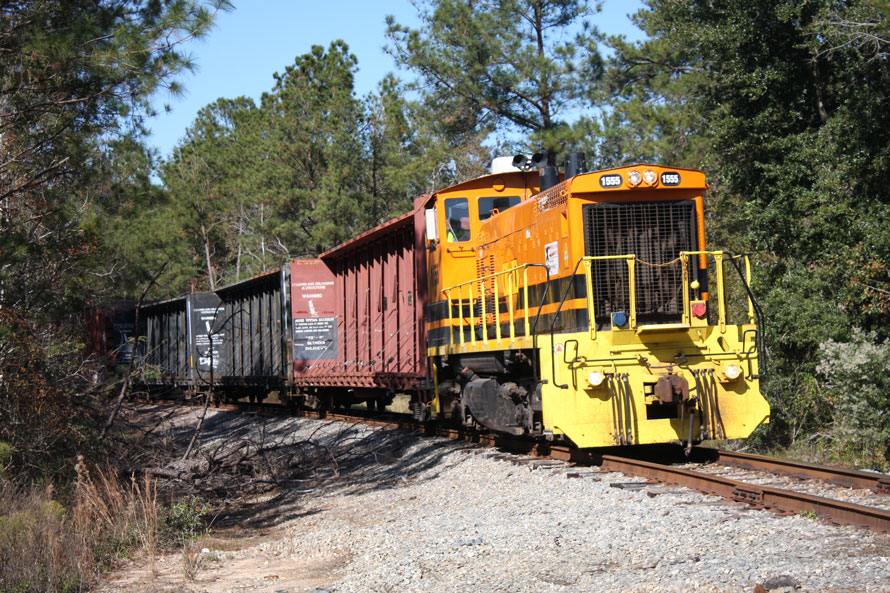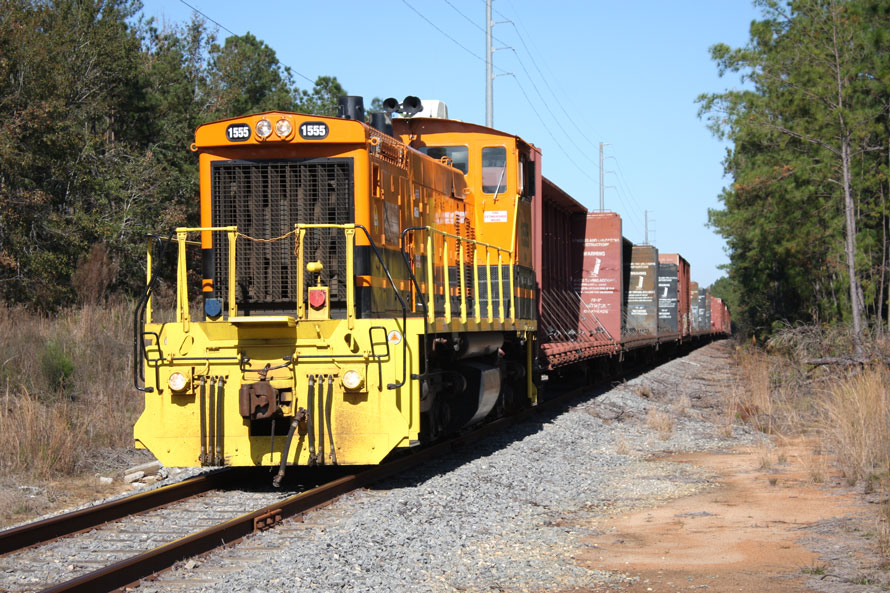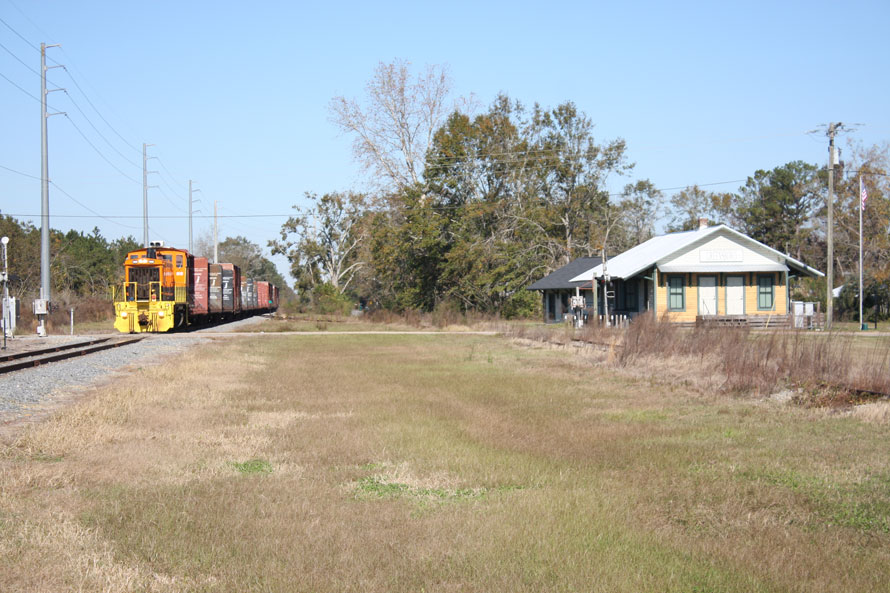
When people think of railroading in Florida, they often think of Class 1 giant, CSX Transportation or of the fast intermodal lanes of the Florida East Coast Railroad and, maybe, even the sugar cane of Clewiston’s US Sugar railroad. But there’s one candidate amongst all the short line railroading of Florida that’s been virtually forgotten about: The Apalachicola Northern Railway, now known the AN Railway Co, Under Genesee and Wyoming, Inc.
I grew up in the Florida Panhandle and lived in Crawfordville, situated about twenty-five miles south of Florida’s state capital, Tallahassee, for thirteen years. In my time as a teenager, when opportunity presented itself, I’d explore the CSX in Tallahassee and the local area or make my way to places such as the AN in Apalachicola or places like Greensboro or Chattahoochee. In my time, however, most of it was spent relying on my parents to tote me everywhere until I had a license and a truck to get down the road in. Like most railfans, armed with a scanner, a camera and some hope- I made it a priority to find things that always interested me and one thing is for sure, the AN did.
A historical overview:
The Apalachicola Northern Railway, one of Florida’s oldest railroads, was an established, paper and coal route that operated between Port St. Joe and Chattahoochee, Florida, via its namesake town of Apalachicola, located on the southernmost point of the “big dip” in the panhandle. Established in April, 1903, construction of the railroad began in March, 1905 and trains began operating north from Apalachicola in 1907. An extension to Port St. Joe was completed in May, 1910. The company operated under receivership from July, 1907- October, 1908, May, 1914 to February of 1916 and May, 1932 to December, 1936. Alfred Dupont in 1936 purchased the railroad along with the town of Port St. Joe and all of its interests which remained intact under the Dupont testamentary trust from 1936 to 1996. In 1996, the railroad was sold to the St. Joe Company and remained under the St. Joe Company until Rail Management Corporation purchased the railroad September 1st, 2002. The ownership of the railroad under RMC would exist until the AN and all interests of RMC and its different railroads were purchased by Genesee and Wyoming, Inc. Currently, the AN is operated only between the Florida, Gulf and Atlantic (FGAR) interchange at Chattahoochee to the out of service portion north of Sumatra as of 2021. About forty miles of track, only to which they operate to Hosford and Telogia.
Motive power:
In the 1960’s, AN received eight EMD SW1500’s equipped with A/C to fight the Florida heat, and full light packages The motors were assigned road numbers (719-712) and were operated on road trains. The AN at the time also had three SW900’s, all three of which were purchased by Conrad Yelvington in the early 2000’s. They were numbered (711-709). In 1983, The railroad received three brand new EMD GP15T’s, a turbocharged switcher designed for hauling and fit AN’s motive power needs. They also came equipped with A/C and full light packages, with no snow plows. All three GP15T’s were later repainted under G&W but did not leave AN property until late 2009. Once gone, they served on other G&W properties and the last one to be repainted, 721, got the orange dip in late 2019. Most of the SW1500’s remain on G&W owned railroads and were repainted and renumbered, accordingly.
The Apalachicola Northern Railway’s Operations:

Photos taken December 4th, 2019.
The little railroad was a major paper hauler and in later years, on top of paper hauling from the late 1980’s to the very late 1990’s, they operated coal trains transloaded from barges to railcars and handed off to the CSX to be shipped to Seminole Electric’s Palatka, Florida power plant. Coal trains were operated by themselves and were a daily occurrence with one train in each direction per day (one loaded north, one empty south). In its prime, the railroad handled over 15,000 rail cars per year of short pulpwood, wood chips, scrap paper, magnesium, concrete and chemicals from Arizona and General chemical companies. In production, the railroad also hauled lime/soda ash and worked a warehouse at the paper plant. There was a daily mixed freight out of Port St. Joe as train 72 north and train 73 south until the mid 1990’s. The train carried blocks of traffic for Pensacola, Tallahassee and Waycross. Coal trains would often follow the northbound out of Port St. Joe as train 82 and return , empty as train 83.
The decline of the AN came in the late 1990’s when the coal contract was coming up and CSX found a way out of the contract and began operating directly from the northeast to bring the trains south to Palatka- skipping AN. At the same time, the paper mill was losing millions in value and in just a matter of time, the paper plant was in imminent danger of being closed. In late 1998 The St. Joe Company would stop production at the paper mill and give over 700 employees at the paper mill walking papers by the first of 1999 and left a majority of the town and railroad, grasping for work. In 1999, the railroad laid off a majority of its labor force who would never get a call back to service, including a friend of mine, Cleve Pridgeon of Wewahitchka, who was an AN locomotive engineer from 1977 to 1999. By this time, wood chips and short pulpwood loaders along the AN had long ceased and scrapping of the paper plant kept the railroad ironically in business hauling it out in gondolas one car at a time for about three years. During this time, Premier Services and Arizona chemical were still in business. Attempts to revive the MTI transload with pet coke was short-lived and now is being slowly reclaimed by the elements. From 2002-2005, the railroad operated under a Monday and Wednesday schedule and operated a road train to Chattahoochee on those days and would also run on Friday’s, occasionally. In 2005 when G&W acquired the AN, they sold the three SW900’s and a couple of the SW1500s, too. About 4-5 SW1500’s and three GP15T’s remained until 2008 when business began to dry up in Port St Joe. In 2006 shop forces and carman were axed and some offered relocation to Panama City. During this time, AN was still hauling from both remaining customers in Port St. Joe and had one other customer at Telogia loading cut timber on center beams. The SW1500’s would be shipped off by 2008 and shortly thereafter, Arizona chemical announced the closure of their plant in July 2009. That left only Premier services, which would close up shop by 2010.
With only car storage left and remaining Premier Services, the railroad’s southern half was in grave danger. Fortunately in 2009, Georgia Pacific built an oriented strand board plant in Hosford, which allowed new business opportunity on the north end, saving the railroad. In early 2011, bridge records from a friend indicate the last train came north from Port St. Joe and the bridge swung out for river traffic. The port has been sitting dormant since with all buildings (minus the office and open air car shop), intact. In 2014, G&W and CSX partnered with Chesapeake Bay, Maryland and Gulf Coast aggregates of Carrabelle, Florida, to haul fossilized oyster shells from a loading site at Telogia (where the shells were trucked to from Carrabelle) and loaded on CSX hoppers for shipment. The several times the train ran, it carried CSX power to Hosford where it laid over while being loaded. It operated on CSX from Chattahoochee as K198 and returned empty as K199. This attempt at business was short lived, however, once the new oyster beds were established. In late 2019, AN began clearing the right of way and repairing signs and crossing signals between the mainline below the GP plant at Hosford to Telogia as the railroad gained a new customer (with a three year contract) at Telogia in 2020. The railroad currently operates with a single SW1500 (CIRR 1555) which is former AN 719 and operates on Wednesday around 7-8 am with two types of product from GP and hauls loaded center beams of untreated crossties out of Telogia, to interchange and be shipped off for treatment and then returned back south to Telogia for unloading. Most of the railroad’s traffic is west bound for Pensacola and the railroad also handles storage cars, usually stored at the very long A&N yard in Chattahoochee.

The AN was known for being very railfan friendly and often allowed people to take photos in the service area and places that in today’s time, are usually off limits. Railfans would just get some weekend rosters in Port St. Joe. The railroad made a good choice for the rail fan to make quick photo business of, especially on a trip to the beach or while visiting nearby Panama City, but times change unfortunately and now Port St. Joe’s facility rest dormant, a sad sight to the railfan. Now, the railroad in more recent times has hung on by pure determination of the management of G&W and trying to find ways to bring business back to the mighty AN. The main line is comprised of concrete ties and 120 pound jointed rail just as the Dupont’s wanted it. There has been very recent interest in repairing the several bridges between Sumatra, Apalachicola and Port St. Joe- but that’s just talk so far. The AN has been a forgotten soul of the railroading community, running through the deep pines of the Apalachicola National forest and along the pine knot swamps that comprise most of the area where the railroad runs. The Port St. Joe route has always been a treat to the railfan, the churn of the EMD 567 diesel exhaust choking the humid, salty air and making a break in the gulf breeze for a few moments as they pass by unannounced as that engineer opens up on the throttle and horn to the communities they pass through. The AN as we know it, in its past and current form, still makes its rounds toting its freight one car at a time.. load by load to the customer as it has since 1907.
C. Michael Appleby – Photographs and text Copyright 2021
Really nice summary. I live in Tallahassee and did some rail fanning song the line in the 90s while it was still thriving along the full route.
Enjoyed the article. Good job recording the history of a classic.